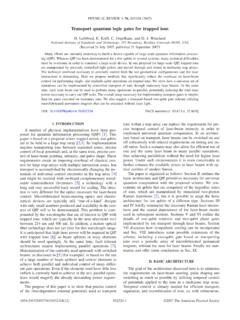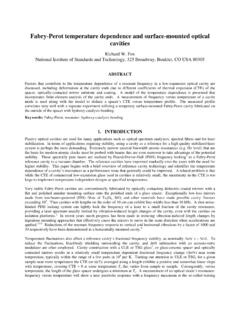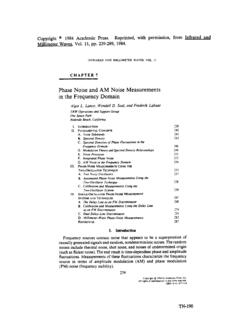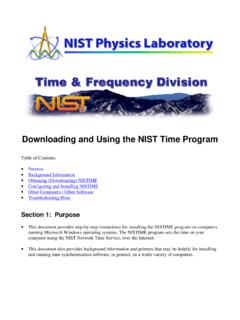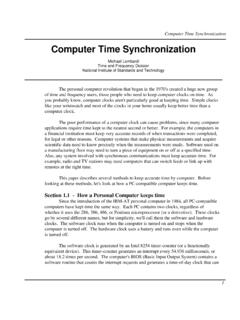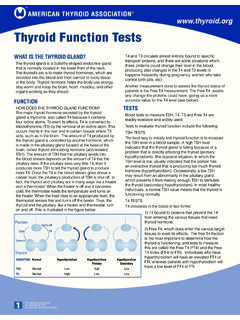Transcription of Chapter 17: Fundamentals of Time and Frequency - NIST
1 17 Fundamentals of Time and Frequency Int roduction Coordinated Universal Time (UTC) Time and Frequency Measurement Accuracy Stability Time and Frequency Standards Quartz Oscillators Rubidium Oscillators Cesium Oscillators Time and Frequency Transfer Fundamentals of Time and Frequency Transfer Radio Time and Frequency Transfer Signals Closing Introduction Time and Frequency standards supply three basic types of information: time-of-day, time interval , and Frequency . Time-of-day information is provided in hours, minutes, and seconds, but often also includesthe date (month, day, and year). A device that displays or records time-of-day information is called a clock . If a clock is used to label when an event happened, this label is sometimes called a time tag or timestamp.
2 Date and time-of-day can also be used to ensure that events are synchronized , or happen at thesame time. Time interval is the duration or elapsed time between two events. The standard unit of time intervalis the second(s). However, many engineering applications require the measurement of shorter timeintervals, such as milliseconds (1 ms = 10 - 3 s), microseconds (1 s = 10 - 6 s), nanoseconds (1 ns = 10 - 9 s),and picoseconds (1 ps = 10 - 12 s). Time is one of the seven base physical quantities, and the second is oneof seven base units defined in the International System of Units (SI). The definitions of many otherphysical quantities rely upon the definition of the second. The second was once defined based on theearth s rotational rate or as a fraction of the tropical year.
3 That changed in 1967 when the era of atomictime keeping formally began. The current definition of the SI second is:The duration of 9,192,631,770 periods of the radiation corresponding to the transition between twohyperfine levels of the ground state of the cesium-133 is the rate of a repetitive event. If T is the period of a repetitive event, then the Frequency f is its reciprocal, 1/ T . Conversely, the period is the reciprocal of the Frequency , T = 1/ f . Since the periodis a time interval expressed in seconds (s), it is easy to see the close relationship between time intervaland Frequency . The standard unit for Frequency is the hertz (Hz), defined as events or cycles per Frequency of electrical signals is often measured in multiples of hertz, including kilohertz (kHz),megahertz (MHz), or gigahertz (GHz), where 1 kHz equals one thousand (10 3 ) events per second, 1 MHz Michael A.
4 Lombardi National Institute of Standards and Technology 2002 CRC Press LLC equals one million (10 6 ) events per second, and 1 GHz equals one billion (10 9 ) events per second. Adevice that produces Frequency is called an oscillator . The process of setting multiple oscillators to thesame Frequency is called syntonization . Of course, the three types of time and Frequency information are closely related. As mentioned, thestandard unit of time interval is the second. By counting seconds, we can determine the date and thetime-of-day. And by counting events or cycles per second, we can measure interval and Frequency can now be measured with less uncertainty and more resolution thanany other physical quantity. Today, the best time and Frequency standards can realize the SI second withuncertainties of.
5 Physical realizations of the other base SI units have much larger uncertainties,as shown in Table [1 5].Coordinated Universal Time (UTC) The world s major metrology laboratories routinely measure their time and Frequency standards andsend the measurement data to the Bureau International des Poids et Measures (BIPM) in Sevres, BIPM averages data collected from more than 200 atomic time and Frequency standards located atmore than 40 laboratories, including the National Institute of Standards and Technology (NIST). As aresult of this averaging, the BIPM generates two time scales, International Atomic Time (TAI), andCoordinated Universal Time (UTC). These time scales realize the SI second as closely as possible. UTC runs at the same Frequency as TAI. However, it differs from TAI by an integral number of difference increases when leap seconds occur.
6 When necessary, leap seconds are added to UTC oneither June 30 or December 31. The purpose of adding leap seconds is to keep atomic time (UTC) within s of an older time scale called UT1, which is based on the rotational rate of the earth. Leap secondshave been added to UTC at a rate of slightly less than once per year, beginning in 1972 [3,5].Keep in mind that the BIPM maintains TAI and UTC as paper time scales. The major metrologylaboratories use the published data from the BIPM to steer their clocks and oscillators and generate real-time versions of UTC. Many of these laboratories distribute their versions of UTC via radio signals, whichare discussed in section can think of UTC as the ultimate standard for time-of-day, time interval, and Frequency . Clockssynchronized to UTC display the same hour, minute, and second all over the world (and remain withinone second of UT1).
7 Oscillators syntonized to UTC generate signals that serve as reference standards fortime interval and Frequency . Time and Frequency Measurement Time and Frequency measurements follow the conventions used in other areas of metrology. The fre-quency standard or clock being measured is called the device under test ( DUT ). A measurement comparesthe DUT to a standard or reference . The standard should outperform the DUT by a specified ratio, calledthe test uncertainty ratio ( TUR ). Ideally, the TUR should be 10:1 or higher. The higher the ratio, the lessaveraging is required to get valid measurement results. TABLE Uncertainties of Physical Realizations of the Base SI Units SI Base Unit Physical Quantity Uncertainty Candela Luminous intensity 1 10 - 4 Kelvin Temperature 3 10 - 7 MoleAmount of substance8 10 - 8 AmpereElectric current4 10 - 8 KilogramMass1 10 - 8 MeterLength1 10 - 12 SecondTime interval1 10 - 1511015 @ 2002 CRC Press LLC The test signal for time measurements is usually a pulse that occurs once per second (1 pps).
8 Thepulse width and polarity varies from device to device, but TTL levels are commonly used. The test signalfor Frequency measurements is usually at a Frequency of 1 MHz or higher, with 5 or 10 MHz beingcommon. Frequency signals are usually sine waves, but can also be pulses or square waves. If the frequencysignal is an oscillating sine wave, it might look like the one shown in Fig. This signal produces onecycle (360 or 2 radians of phase) in one period. The signal amplitude is expressed in volts, and mustbe compatible with the measuring instrument. If the amplitude is too small, it might not be able to drivethe measuring instrument. If the amplitude is too large, the signal must be attenuated to preventoverdriving the measuring section examines the two main specifications of time and Frequency measurements accuracy and stability.
9 It also discusses some instruments used to measure time and Frequency . Accuracy Accuracy is the degree of conformity of a measured or calculated value to its definition. Accuracy isrelated to the offset from an ideal value. For example, time offset is the difference between a measuredon-time pulse and an ideal on-time pulse that coincides exactly with UTC. Frequency offset is the differencebetween a measured Frequency and an ideal Frequency with zero uncertainty. This ideal Frequency iscalled the nominal Frequency .Time offset is usually measured with a time interval counter ( TIC ), as shown in Fig. A TIC hasinputs for two signals. One signal starts the counter and the other signal stops it. The time intervalbetween the start and stop signals is measured by counting cycles from the time base oscillator.
10 Theresolution of a low cost TIC is limited to the period of its time base. For example, a TIC with a 10-MHztime base oscillator would have a resolution of 100 ns. More elaborate TICs use interpolation schemesto detect parts of a time base cycle and have much higher resolution 1 ns resolution is commonplace,and 20 ps resolution is available. FIGURE An oscillating sine wave. FIGURE Measurement using a time interval counter. 2002 CRC Press LLC Frequency offset can be measured in either the Frequency domain or time domain . A simple frequencydomain measurement involves directly counting and displaying the Frequency output of the DUT witha Frequency counter . The reference for this measurement is either the counter s internal time base oscillator,or an external time base (Fig.)
